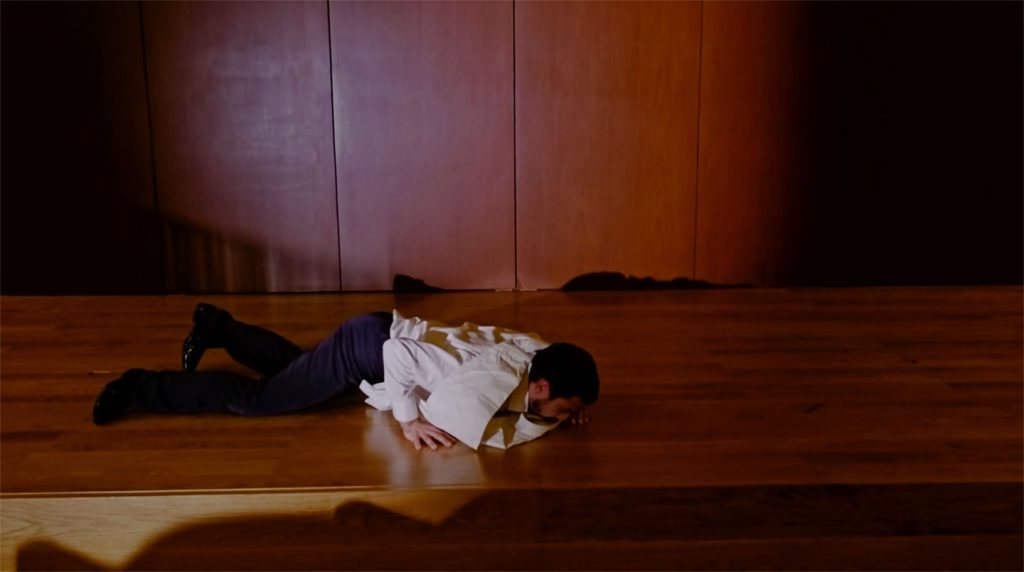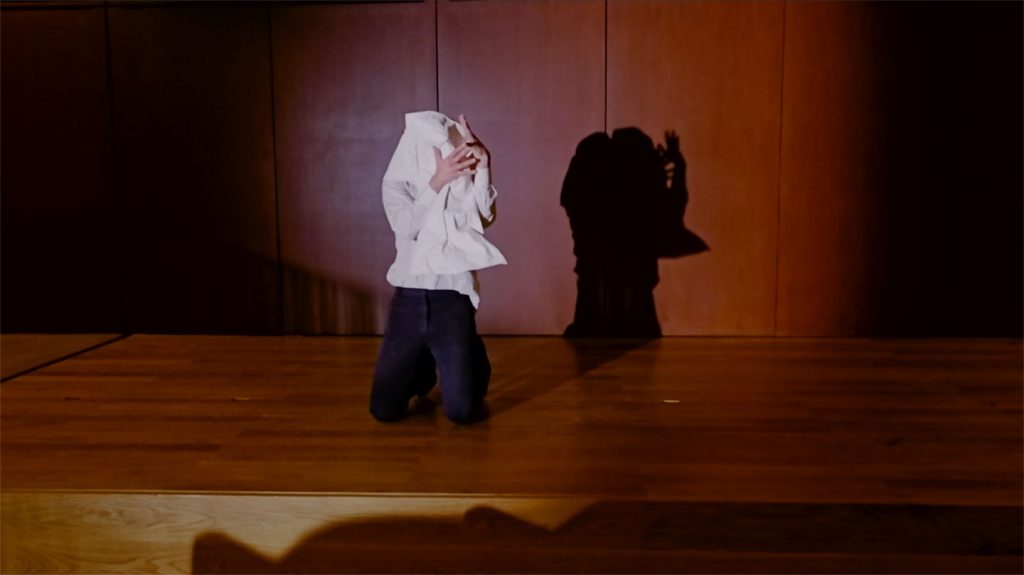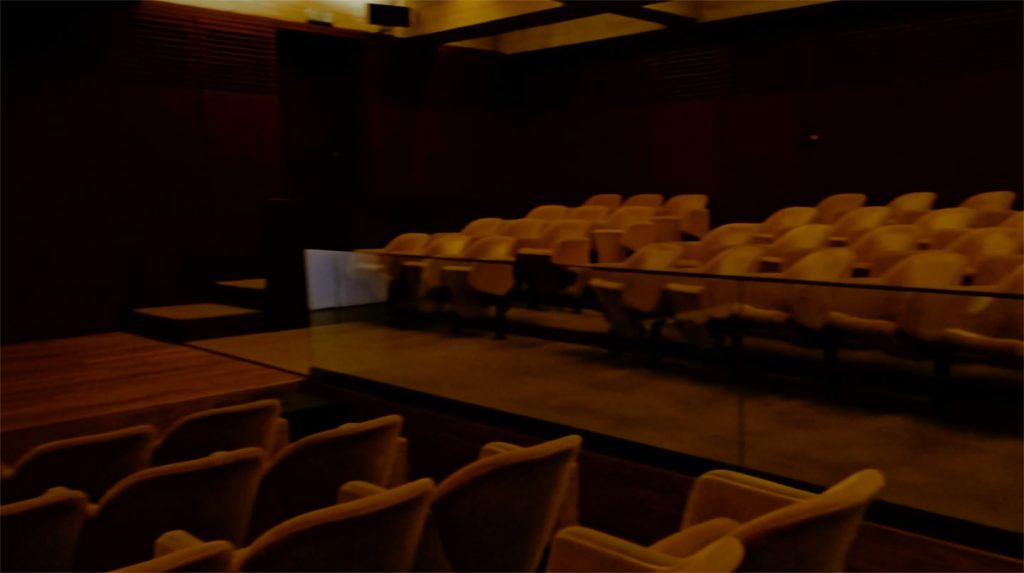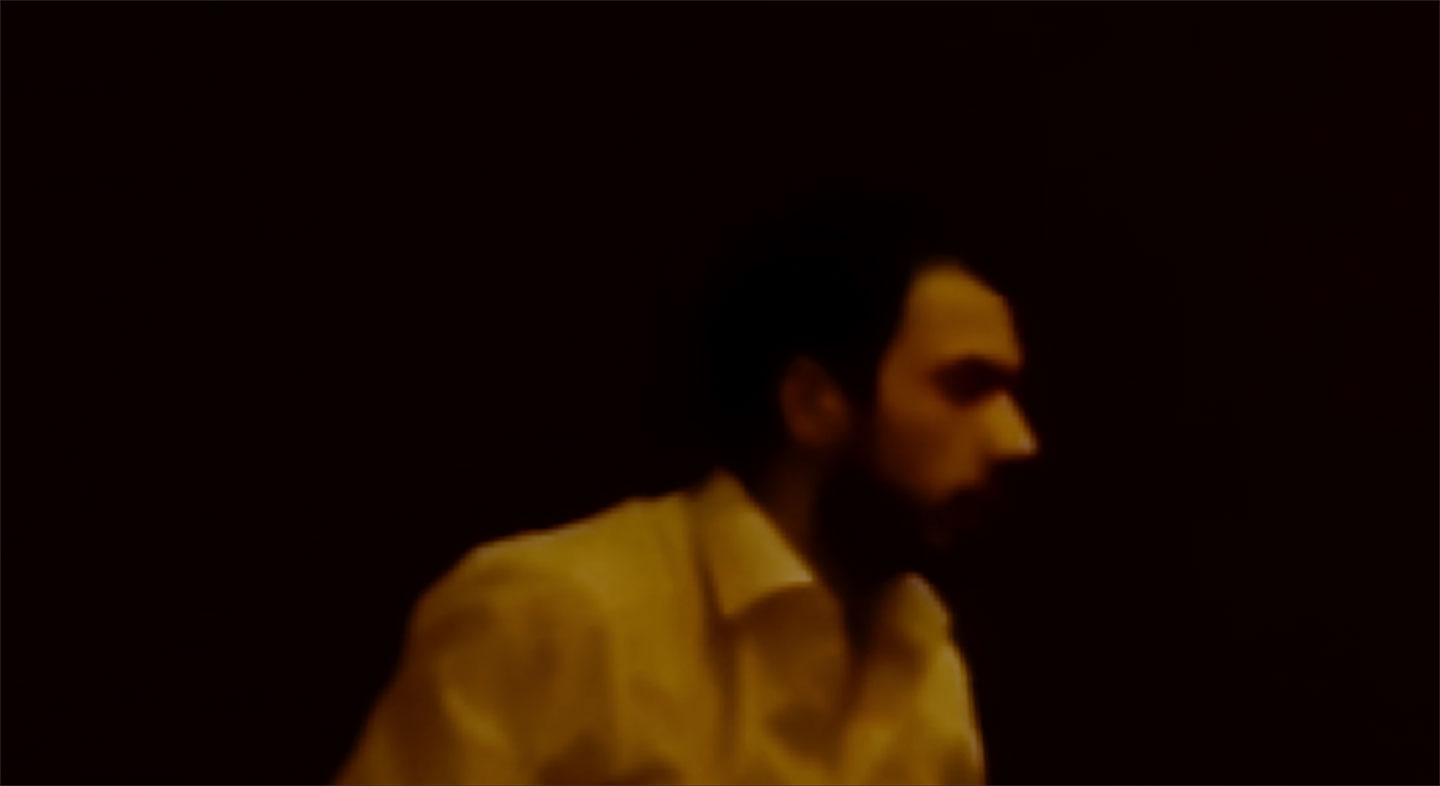Let’s start with something that is essential to your work: the relation to performance, and how you would say it evolved over time.
I am working on a new film, No Trace of Accelerator, which is loosely based on a case study regarding the social amplification of risk. The study looks into a series of fires in France in the mid-1990s. I had been thinking about fire for a while—as a structure for thought or for modeling thinking—and I have always been interested in the case study as a sort of stopping-off point on the way to learning. A point where thought becomes fixed into a concrete set of events or objects, and those objects or events are supposed, somehow, to be “transparent,” since they exist only in order to clarify or be interpreted.
Since fire is so difficult to predict and model computationally, when I found a case study that centered on fire, this contradiction attracted me. I went to the village in the French Jura where the events took place and researched the court documents from that time. The reason it was used as a case study was that the “amplification” of the risk was very extreme, provoking a crisis that reached national levels and involved the electricity company, the fire service, the police, everyone in the village, the national media, the mayor, the local industry, and eventually paranormal experts.
Thinking about fire, I was brought back again to improvisation. With No Trace of Accelerator I will be working a lot in “performance” as something where you don’t know the end at the beginning—you can’t—because if you did, the performance would become “un-lifelike.” Performance, that of an actor, seems to me like an opening up, a kind of courage. I read a few days ago a description by James Baldwin of a musician improvising, it seemed also to be about this kind of channeling:
All I know about music is that not many people ever really hear it. And even then, on the rare occasions when something opens within, and the music enters, what we mainly hear, or hear corroborated, are personal, private, vanishing evocations. But the man who creates the music is hearing something else, is dealing with the roar rising from the void and imposing order on it as it hits the air. What is evoked in him, then, is of another order, more terrible because it has no words, and triumphant, too, for that same reason. And his triumph, when he triumphs, is ours.1
It is an abstract roar, nothing shaped into a word or an action, but I think it is the same courage and maybe even the same distinction between performer and spectator. That the performer, when they are really “on,” is dealing with something and letting it pass through him or her. So when you talk about performance now, that is what I think about.
In a way, it is the opposite of what I was trying to do with Game Keepers without Game (2010), where I was “executing” a script. The filmmaker Phil Solomon talks about this with respect to his work—that he would never “execute” a script, as for him the idea, like the word, is too deathly. But with Game Keepers without Game, that sense of the inevitable, this sense that everything was “sewn up,” was very important. The filming was extremely controlled, following a set of rules: objects were status symbols, or theatrical props or evidence of crime. Everything shot in separation. The structure was also familiar and conventional. It had to feel that when Dad died, this was already written.
EB: The brain and its meanderings is a recurring focus in your work, be it through an existing figure that you adopt as the origin of your project—I am for example thinking of Sarah Winchester, the central character of your film Fulll Firearms (2011)—or rather through a certain disorder that is embodied for instance in the patient of When You Fall into a Trance (2013). Where does this attraction come from?
EW: With Fulll Firearms I was interested in the idea of the past haunting the present. The story of Sarah Winchester—who built a house to accommodate the ghosts of people killed by the guns that created her family’s fortune—carries within it so much thwarted hope and excess, memories walking in among the present and misdirected attempts to build walls that might house the nebulous. I think that this was my attraction, rather than Sarah Winchester’s specific brain.
With When You Fall into a Trance, one of the main characters has a condition where he loses his proprioception, so he cannot move his body without looking at it. I was interested in what this disconnect, which is very rare, did to movement and vision. Also in connections between this and descriptions of the body online, as “meat.” I was thinking of different ways in which a separation is made between brains and bodies. And the visual way to think about this was through diffraction and distortion—for instance when you have a camera half in and half out of the water to shoot a swimmer, and it divides the body from the head. We built large, undulating mirrors that would distort the body like in André Kertész’s Distortions series from the 1930s. When Luca Massolin made the music for me—he was listening to a lot of new age music at the time—this idea of mind-body healing entered into the soundtrack.
EB: It seems to me that cinema is actually at the core of everything. It is of course always a certain reference for artists’ film in general, on different levels and in various ways. But in your case, I cannot help wondering whether you regularly work with the structure and narrative of a feature-length film in order to, again and again, undermine it, destroy it, reappropriate it, reconsider it, et cetera. What is your relation to cinema, personally and in your work?
EW: Honestly, I don’t know what it is. Cinema. It is so open to interpretation and nuance that it changes form as it changes country and decade and discipline. It might even be more interesting to think about it as sculpture, or as event. I remember when the curator and artist Ian White constructed his Kinomuseum in Oberhausen, Germany, and imagined the cinema as a museum—this was a very important moment for me—for thinking about what cinema is as a space that we sit in together and experience together, about what it could be now, rather than only historically what it was. Because cinema for me is full of many opportunities: in terms of brains and bodies, social bodies, process, as a way to think about material (I mean the material of the film), reinvestigation of histories, technology, duration (consideration of duration), art practice.
I think back so often to materialist film in particular, and its way of thinking about film as an object in and of itself, and not a transmitter of messages. There is this metaphor by Henri Bergson where he is bemoaning the omission of duration from philosophy, and he compares our brain’s obsession with fixed moments to a film (analog) that can be run at any speed without changing the “content.” I think that for someone like Peter Gidal, this emphasis on duration signals a way of thinking of presence, too, and an attempt not to separate form from content. If you “disrupt,” as you put it, the idea that film is a means to an end, whatever that end might be—to educate or to distract, let’s say—then you bring the audience back to a different space.
I work with something like a narrative or a structure, and the things that I was educated to think were suspicious—like spectacle—since I think, as you say, it is possible to build and destroy in that space, and to reappropriate toward your own duration. I was looking at Glenn Brown’s painting The Suicide of Guy Debord (2001) yesterday, and I was thinking about how we do this now—we take these highly emotive conditions and we don’t express them anymore, but we quote them. Debord’s suicide—an end that he really must have hoped was the end. We don’t use emotions because we are tired of being used up by them, but at the same time, we cannot quite let go and we want to feel, so our feelings got thrown in and out of focus and so dismembered from their sources that we cannot trust them any longer. But still, to give up on them completely seems like a pathetic surrender. So we are stuck in limbo.
It is still hard to write a love letter. Probably harder than it ever has been. So when you try to deal with these things in your work—the things that artists have always tried to deal with—and you are working with moving image or any art practice, you are in a strange arena, full of transmogrified artifacts of all of those things, walking around and attempting to coalesce into a recognizable thing. But that recognizable thing doesn’t have to look like anything you ever saw before. In fact, the opposite. I suppose what I hope is that these technologies that we beget, and that then beget further technologies, initially reflect something about us, even if that reflection is faded through multiplication. But we don’t lose our responsibility toward it; we are still influencing this technology that influences us. As Bruno Latour says, we have to “love our monsters” (he argues that we don’t just invent them and let them go, but “raise” them). It is this relationship with “cinema” that I find inspirational, I think—that it is still open, with all its histories and rules and models and ridiculous expense and conventions—to be a monster we can love and help to grow and keep on growing.
EB: Ian White’s Kinomuseum definitely was an interesting, and relevant, project and framework to rethink cinema. He continued it in Berlin and invited several artists to respond to a few seminal films—there were split screens, performances interrupting films, and so on. Although, what you succeed in doing is for me slightly different, as you are challenging things from within the narrative, which I personally find thrilling.
EW: Thank you.
EB: Nonlinearity, that of the brain, that of the thought or of memory, seems often reflected in your films through various dispositives: the discrepancy and distance of sound and image, the staging of different point of view, the splitting in two of the image (inside and outside, for example in The Third Person [2012]). I wonder why you are keen on deconstructing, and if perhaps it relates to the way you want the spectator to receive the film?
EW: The ability to swap perspectives, swap bodies, swap minds, move eyes around in a way that we can’t in reality, to make what we see closer to what we imagine, to jump physically how we can jump conceptually—that is something “cinema” has always been concerned with. I think also that there is a way to open things up—portals—when you don’t try to use sound in service of image and image in service of narrative. Maybe it is not just about mirroring consciousness, but about creating cracks to fall down into, or dimensions that are not automatic.
EB: In The Pips (2011) you remove the sound, but send through the title an almost subliminal message, the air of a song, that responds to the musicality of the body movements. How did you come to the decision to work this way?
EW: That is a beautiful way to put it. Actually I didn’t think about it that way, but I like the idea that someone would have the song in their head through subliminal suggestion while watching the film. In The Pips, she is drawing in the air, and the ribbon (which is the ribbon from “take the ribbon from my hair”) is like a filmstrip and it is shot on 16mm. Though you then realize at the end that it is digital and she falls apart, but not through the image disintegrating; her actual body falls into parts.
EB: Language certainly is a central dimension of your work—its limitations, its materialization through the voice. I wonder as well if there isn’t something emotional related to its materiality. It often appears through a voice-over, disconnected from the body, which is even more interesting if one considers the fact that sound addresses different parts of the brain. Surely there are different kinds of voices as well.
EW: I think a lot about language trying to be an image, or an image trying to be written. When Roland Barthes writes about Arcimboldo he talks about this: that the images are written, they have a kind of lexicon to them. He says, “It is as though Arcimboldo were violating the pictorial system, improperly dividing it in two. . . . It is because everything signifies at two levels that Arcimboldo’s painting functions as a somewhat terrifying pictorial language.”2 Arcimboldo is “violating the pictorial system” because he is not allowing the image to be image—the fish is a nose, the apple is a cheek. Together they are people, and those people are full of significance, which denies the image.
I try to use voice-over to occupy different spaces. With SEA OAK (2008) that is all there is, there is no image. But the language really wants to be a thing inside your head. It gives you an image—it tells you what that image is and then it pretends, somehow, that this image is universal, so you feel connected to a larger sense of understanding.
People talk about voice-over being “non-filmic.” I like the idea of a film that is not of film. Or maybe a sculpture that is non-sculpturic. Or that a relief is like a sculpture that is embarrassed to be a sculpture, so it hovers close to the wall to hide.
My interest, and this relates back to your question, is more to do with one thing wanting to be another thing. Things that want to be other things have within them an inherent sense of desire. In the case of words wanting to be images or images wanting to be words, that desire is impossible. The sculpture can’t be flat, because then it would be a wall. The line can’t be invisible, the film can’t be music, and the word can’t be concrete.
EB: This reference to Barthes and Arcimboldo is very interesting indeed; I had forgotten about this. For my part I was actually thinking of Marguerite Duras’s film Le Camion (The Lorry, 1977), in which she disrupts the cinematic system of representation. Refusing to subordinate the text to the image, she is sitting with the French actor Gérard Depardieu and reading, as well as discussing, the film’s script. Even if those scenes regularly cut to images of a dark lorry driving in the countryside and involving two figures who could be them, one can never be certain of the boundary between reality and fiction. Duras explains in the film: “Cinema freezes text, kills its progeny: the imagination. That’s even what it does best. To close, put a stop to the imagination.” I guess there is also something about a film not being of film, to some extent.
EW: Yes, that is why you would leave space. Sometimes so that the sound doesn’t do the dirty work for the image—filling in duration—and sometimes so that the imagination makes its own images. Didn’t she also play her actors music that we don’t hear in the film? “India Song”?
EB: Yes, it is like there are actually two films. She says there is one with the voices and one with the images. Which not only produces an odd desynchronization, but also at times superimposes outdoor sounds on indoor sequences, for instance.
Contrarily, your new work I gave my love a cherry that had no stone (2016) most of the time is silent, to the extent that one not only misses sound, but also welcomes it when it emerges as a disruptive or somewhat sinister presence.
EW: The soundtrack comes from behind in the space, and it will appear close to you from nothing, like a sound phantom, and then slip away quietly, only just avoiding getting its tail trapped in the door.
EB: Tell us a little more about this lonely figure and his ghosts, and about how this piece emerged from your current interests.
EW: I became a bit besotted with a painting by Dorothea Tanning: Some Roses and Their Phantoms (1952). She depicts a tablecloth, creased with folds, and “roses” that sit on it. But they don’t look like roses; instead they are crystalline, crumpled-up, impossible brown geometrical riddles. Something like origami or a crashed car. And everything seems normal, but these exceptional things are there, looking blithe and gridded by the folds in the tablecloth.
It is of nature and the supernatural, and for me it feels contemporary and past. The colors of the painting are the same as the interiors of Museu Calouste Gulbenkian and I wanted to sort of invert the painting but also perform it. The space outside the auditorium seems to point in a couple of directions—past and future—and the film does that, too. This “lonely figure,” as you call him, seems to be having his sense of body and space mocked by the film itself. Nothing belongs; it could all be computer generated, and the museum feels haunted by the future.
Notes
- James Baldwin, “Sonny’s Blues,” in Going to Meet the Man
- Roland Barthes, Arcimboldo, or Magician and Rhétoriqueur (1978)

















